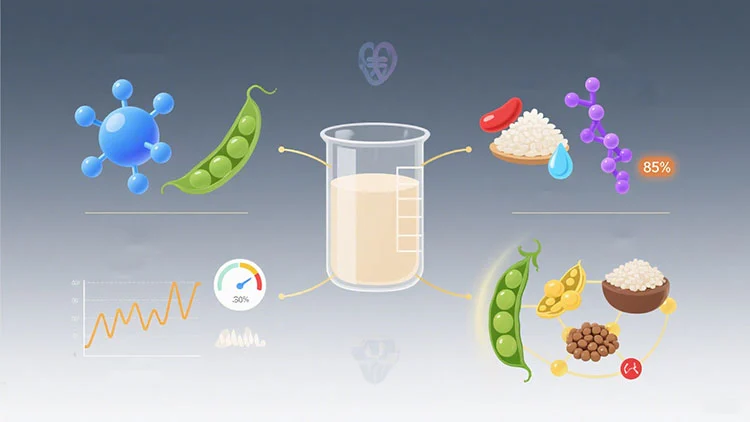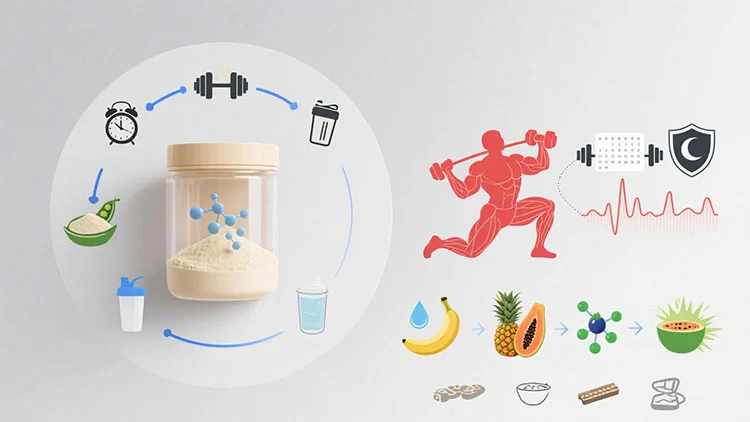How Does Pea Protein Powder Support Muscle Growth?
As a growing number of athletes, health-conscious consumers, and fitness fanatics seek for plant-based protein alternatives to enhance muscle growth, pea protein powder is swiftly rising to the ranks of the leading sports nutrition brands. An examination of the precise amino acid composition, bioavailability, and physiological consequences on muscle protein synthesis is important to appreciate the mechanism by which pea protein powder supports muscular development. A comprehensive dietary supplement with muscle-building properties comparable to those of traditional animal proteins, pea protein powder is made from high-quality yellow peas (Pisum sativum L.) using modern wet milling, isolation, and spray drying methods. Essential for muscle growth, repair, and maintenance, this fine, light-yellow powder contains 80-85% protein and essential amino acids including lysine and arginine. If you're trying to ensure that your plant-based or dairy-free diet is as effective as possible without sacrificing any of the advantages, hypoallergenic pea protein powder is a great option. Sustainable production practices further ensure its low environmental impact. The pea protein powder
What Makes Pea Protein Powder Effective for Muscle Building?
Complete Amino Acid Profile and Muscle Protein Synthesis
The whole set of nine amino acids required to build muscle is included in pea protein powder, making it a great source of growth and repair amino acids. Lysine, arginine, and BCAAs are abundant in it as well, and they help with tissue repair and development. Though the amounts of leucine are not as high as in whey, they are sufficient to initiate protein synthesis via the mTOR pathway. Muscle growth is facilitated by the increased blood flow and nutrient delivery brought about by the high arginine concentration. The body makes efficient utilization of pea protein because it is highly bioavailable and has excellent digestion, on par with animal proteins. Because of its well-rounded makeup, it promotes complete muscle growth without sacrificing structural proteins or functioning enzymes.
Digestibility and Absorption Rates
Pea protein powder is an excellent esse delivery option because to its ease of digestion, rapid nutrient absorption, and low gastrointestinal distress. Its neutral pH, lack of allergenicity, and inability to aggregate make it perfect for usage in post-workout rehabilitation as they prevent gastrointestinal problems. Pea protein powder is prepared in a way that removes anti-nutritional elements that limit absorption without affecting protein integrity, unlike certain other plant proteins. Results from clinical trials demonstrate that amino acid absorption is on par with whey, and that the anabolic window, which occurs during the recovery period after exercise, occurs during the first sixty to ninety minutes after consumption.
Sustained Amino Acid Release and Muscle Recovery
A natural time-release effect that lengthens the anabolic window is created by the unusual structure of pea protein powder, which comprises both fast-digesting and slow-digesting fractions. Those with slower metabolisms or who are elderly may also benefit from this sustained release form, as it helps with strength maintenance in the long run by stimulating muscle protein synthesis over a longer period of time. Consumption of pea protein powder promotes muscle protein synthesis for hours due to its moderate and continuous amino acid release. If you're trying to cut down on muscle loss while fasting or in between meals, pea protein powder is a good option since it stays available throughout the day, unlike fast-absorbing proteins. Because it helps keep the nitrogen balance positive while you sleep, pea protein powder is perfect for taking before bed.

How Does Pea Protein Powder Compare to Other Protein Sources for Muscle Growth?
Performance Against Whey and Casein Proteins
Inquire about appears that after 8 to 12 weeks of resistance preparing, your quality and muscle development will be identical whether you utilize pea protein powder, whey protein, or casein. As an elective to whey protein, which has faster crests, pea protein progresses blood stream and nourishment conveyance due to its higher arginine levels and delayed amino corrosive discharge. The nearness of leucine and BCAAs, which viably improve muscle protein amalgamation, ensures comes about that are on standard with those of other development hormones. There is a few prove that pea protein's anti-inflammatory and anti-oxidant properties can offer assistance with preparing consistency and recuperation. Due to its different preferences, pea protein is an great substitute for dairy-based proteins if you need to pick up muscle without bringing down execution or encountering short-term impacts.
Advantages Over Other Plant-Based Proteins
Pea protein powder is one of the best plant-based solutions since it contains all nine essential amino acids, has a high concentration of lysine, and is very easy to digest. There are no isoflavones in it, unlike soy, thus it won't have any hormonal impacts. Faster absorption is possible with pea protein because it contains more lysine than rice protein and less fat and fiber than hemp protein. Improved efficiency in muscle growth is achieved by digesting it in a way that decreases anti-nutritional elements such phytic acid and trypsin inhibitors. Athletes looking for a reliable source of high-quality plant-based protein might choose pea protein because of its 80-85% protein content, excellent solubility, and simple mixability.
Synergistic Effects with Other Nutrients
Including extra proteins or other supplements upgrades the preferences of pea protein powder. Combining creatine with its tall arginine concentration increments both vitality era and preparing capability. When taken with carbs after a workout, it increments affront affectability and speeds up the assimilation of amino acids. An amino corrosive profile that can compete with or indeed outperform that of creature proteins may be accomplished by combining pea protein with follow amounts of rice protein. Pea protein upgrades execution by encouraging the supply of oxygen to muscles; it is normally tall in press. Consolidating vitamin D and calcium into your supplement schedule with pea protein can offer assistance your muscles contract and work superior in general, giving a more comprehensive approach to building muscle than fair protein on its claim.

What Are the Optimal Ways to Use Pea Protein Powder for Muscle Growth?
Timing and Dosage Strategies
The best way to get the most out of pea protein powder when it comes to developing muscle is to take it at the right times, in match-up with your body's common protein union cycles and workout plans. In order to get the most out of the anabolic window, which happens 30 minutes after a workout, it is prescribed to expend 20-25 g of protein amid that time. Strongly programs advantage from 15-20 g isolated doses each 3–4 hours to keep amino corrosive levels tall and amalgamation going solid. Supporting nighttime recuperation and restricting muscle breakdown, a 25-30 g feast in the evening is prescribed, whereas fasting is not. Take 15-20 g of pre-workout arginine and amino acids 30-60 minutes before working out to progress blood flow and post-training amalgamation. To guarantee a well-balanced dietand meet the day-by-day protein prerequisites for muscle building, which as a rule drop between 1.6 and 2.2 g/kg body weight, a great source of protein is peas, which account for 40-60% of this requirement. Maintained amino acid accessibility, made conceivable by vital timing and the redress measurements, maximizes the potential for recuperation and muscle improvement.
Integration with Training Programs
Pea protein powder is most compelling when combined with resistance training that adequately fortifies the muscle protein blend. Periodized programs utilizing dynamic overload standards work synergistically with supplementation to optimize development. Combining pea protein with compound lifts—such as squats, deadlifts, and seat presses—produces way better outcomesthan segregation works out due to higher union requests. The timing of utilization can be adjusted to prepare objectives: post-workout utilization benefits hypertrophy stages, whereas pre-workout admissions may upgrade quality stages. High-frequency preparing may require more visits and smaller servings to coordinate lifted recuperation requests. Pea protein’s anti-inflammatory properties may diminish soreness and bolster faster recuperation from high-volume sessions, empowering a steady preparing boost. When deliberately coordinated into an organized workout arranged with satisfactory rest, pea protein can essentially make strides in muscle advancement results over time.
Formulation and Preparation Methods
Beyond timing, preparation affects pea protein’s bioavailability and effectiveness. Mixing with water or low-fat plant milk promotes rapid gastric emptying and faster absorption. Pairing with enzyme-rich foods or adding digestive enzymes supports efficient amino acid breakdown and uptake. Post-workout blends with fruits supply simple carbs, improving insulin response and nutrient delivery. Pea protein combines well with creatine for synergistic growth effects. Avoid using high heat during preparation, as it can denature proteins and reduce bioavailability; instead, opt for cold or room-temperature mixes. The powder’s mild flavor allows for versatile use in smoothies, baked goods, energy bars, and meal replacements, supporting overall daily protein goals. Care should be taken to avoid processing methods that compromise protein integrity, ensuring that every serving contributes fully to muscle recovery and growth while providing convenient integration into varied diets.
Conclusion
Due to its full amino acid composition, exceptional digestion, and sustained release properties, pea protein powder offers comprehensive support for muscle building compared to other protein sources. Muscle protein synthesis stimulation, recuperation, and its adaptability to different training and diet plans are the three main reasons for its efficacy.
For premium-quality pea protein powder with 80-85% protein content and exceptional muscle-building potential, Shaanxi SCIGROUND Biotechnology Co., Ltd. offers professionally manufactured products backed by decades of plant protein expertise and rigorous quality standards. Contact us at info@scigroundbio.com to discover how our scientifically-formulated pea protein powder can optimize your muscle growth journey.
References
1. Babault, N., Païzis, C., Deley, G., Guérin-Deremaux, L., Saniez, M.H., Lefranc-Millot, C., Allaert, F.A. (2015). Pea proteins oral supplementation promotes muscle thickness gains during resistance training. Journal of the International Society of Sports Nutrition, 12(1), 3.
2. Gorissen, S.H., Crombag, J.J., Senden, J.M., Waterval, W.A., Bierau, J., Verdijk, L.B., van Loon, L.J. (2018). Protein content and amino acid composition of commercially available plant-based protein isolates. Amino Acids, 50(12), 1685-1695.
3. Banaszek, A., Townsend, J.R., Bender, D., Vantrease, W.C., Marshall, A.C., Johnson, K.D. (2019). The effects of whey vs. pea protein on physical adaptations following 8-weeks of high-intensity functional training. Sports, 7(1), 12.
4. Hevia-Larraín, V., Gualano, B., Longobardi, I., Gil, S., Fernandes, A.L., Costa, L.A., Pereira, R.M. (2021). High-protein plant-based diet versus a protein-matched omnivorous diet to support resistance training adaptations. Sports Medicine, 51(6), 1317-1330.
5. Pinckaers, P.J., Trommelen, J., Snijders, T., van Loon, L.J. (2021). The anabolic response to plant-based protein ingestion. Sports Medicine, 51(Suppl 1), 59-74.
6. Van Vliet, S., Burd, N.A., Van Loon, L.J. (2015). The skeletal muscle anabolic response to plant- versus animal-based protein consumption. Journal of Nutrition, 145(9), 1981-1991.